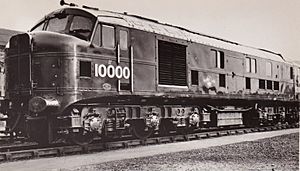British Rail Class D16/1 facts for kids
Quick facts for kids LMS 10000 & 10001(British Rail class D16/1) |
|
 |
|
| No.10000 at Chinley | |
| Power type | Diesel-electric |
|---|---|
| Builder | LMS Derby Works |
| Order number | LMS Lot number 198 |
| Build date | 1947–1948 |
| Total production | 2 |
| UIC classification | Co′Co′ |
| Gauge | 4 ft 8 1⁄2 in (1,435 mm) standard gauge |
| Wheel diameter | 3 ft 6 in (1.067 m) |
| Wheelbase | 51 ft 2 in (15.60 m) |
| Length | 61 ft 2 in (18.64 m) |
| Width | 9 ft 3 in (2.82 m) |
| Height | 12 ft 11+1⁄2 in (3.95 m) |
| Locomotive weight | 127 long tons 13 cwt (285,900 lb or 129.7 t) later 130.65 long tons (132.75 t) |
| Fuel capacity | 815 imp gal (3,710 L; 979 US gal) main 85 imp gal (390 L; 102 US gal) service |
| Prime mover | English Electric 16SVT Mk I |
| Engine RPM range | 450 - 750 rpm |
| Traction motors | EE 519/3B, 6 off |
| Transmission | Diesel electric |
| Multiple working | Yes |
| Power output | 1,760 hp (1,310 kW) gross, 1,600 hp (1,190 kW) net |
| Tractive effort | 41,400 lbf (184,000 N) max |
| Train heating | Clarkson Steam generator, later replaced by Spanner 2,000 pounds (910 kg) per hour model |
| Train brakes | Vacuum |
| Power class |
|
| Withdrawn | 1963, 1966 |
| Disposition | Both scrapped |
The trains known as LMS 10000 and 10001 were super important! They were the very first big diesel locomotives to run on the main railway lines in Great Britain. This means they were the first large diesel trains built to pull long passenger or freight trains all over the country.
These special trains were built by the London, Midland and Scottish Railway (LMS) at their Derby Works. They were made between 1947 and 1948. The LMS worked with companies like English Electric to create these amazing, new trains.
Contents
What Made These Trains Special?
These locomotives used a "diesel-electric" system. This means they had a powerful diesel engine inside. This engine didn't directly power the wheels. Instead, it ran a generator that made electricity. This electricity then powered electric motors connected to the wheels, making the train move. This was a new and exciting technology for trains in Britain at the time.
Key Facts About Them
Only two of these locomotives were ever built: No. 10000 and No. 10001. They were like test models for future diesel trains.
- Power: Each train had a strong English Electric 16SVT diesel engine. It could produce about 1,600 horsepower.
- Speed: They could reach a top speed of around 93 miles per hour (150 km/h). This was quite fast for trains of that era.
- Size: They were about 61 feet (18.6 meters) long. They weighed over 127 tons. That's as heavy as about 20 large elephants!
- Operators: They were first used by the LMS railway company. Later, they ran for British Railways.
Their Big Impact and End
The LMS 10000 and 10001 were pioneers. They showed that diesel locomotives could work well on Britain's main railway lines. This helped pave the way for many more diesel trains to be built. Eventually, diesel trains replaced most of the steam locomotives.
Even though they were important, these two trains didn't last forever. No. 10000 was taken out of service in 1963. No. 10001 was taken out of service in 1966. Sadly, both were later taken apart for scrap. This means they were dismantled and their materials reused. Even though they are gone, their legacy as Britain's first mainline diesel locomotives lives on in railway history.
Images for kids



